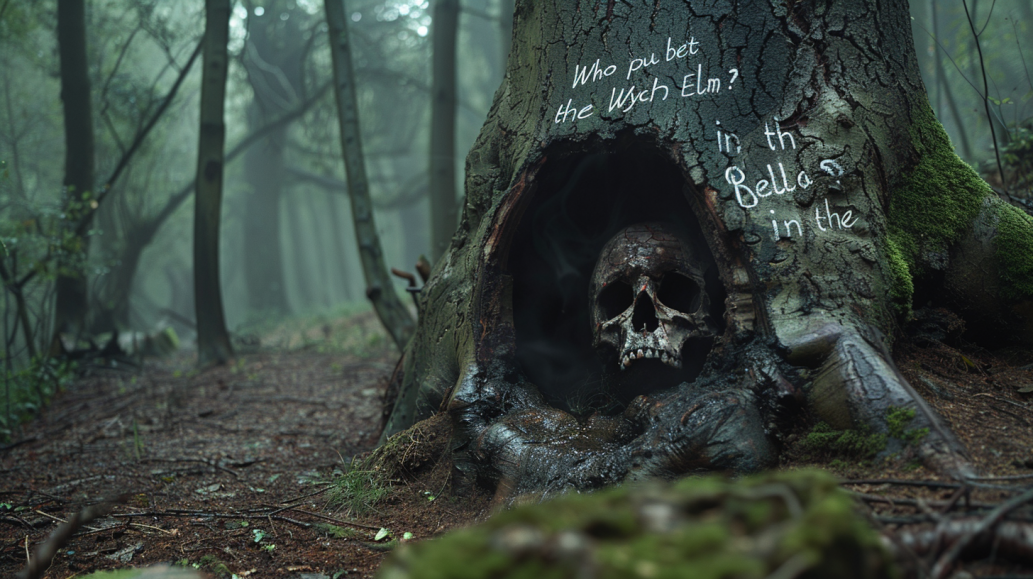Introduction
In 1943, four boys playing in Hagley Woods, England, stumbled upon a chilling discovery—a human skull inside a hollow wych elm tree. This macabre find led to one of England’s most perplexing unsolved mysteries. The remains were identified as a woman, but her identity and the circumstances of her death remain shrouded in mystery. The case took a strange twist when graffiti began to appear, asking, “Who put Bella in the Wych Elm?” Despite extensive investigations and numerous theories, the true story behind Bella’s death continues to haunt England.
The Gruesome Discovery
The Boys’ Find
On April 18, 1943, four boys—Robert Hart, Thomas Willetts, Bob Farmer, and Fred Payne—were exploring Hagley Woods near Wychbury Hill when they found a large wych elm tree. Curious, Bob Farmer climbed the tree and peered into its hollow trunk, only to be confronted by the sight of a human skull. Terrified, the boys fled the scene but later decided to report their find to the authorities.
Police Investigation
The police arrived at the site and discovered the almost complete skeleton of a woman inside the tree. The remains were thought to have been there for around 18 months. Alongside the skeleton, they found a shoe, a gold wedding ring, and fragments of clothing. A piece of taffeta was found in the mouth, suggesting foul play.
The Forensic Analysis
Identification Attempts
Forensic examination suggested the woman was around 35 years old, had irregular teeth, and had given birth at least once. Despite these clues, efforts to identify her through dental records and missing persons reports proved unsuccessful.
Time of Death
Experts estimated the time of death to be sometime in October 1941. The state of decomposition and the presence of taffeta in her mouth indicated she might have been suffocated.
The Mysterious Graffiti
First Appearance
In 1944, a year after the body was discovered, mysterious graffiti began appearing in the vicinity of Birmingham. The first message, written in chalk on a wall, read, “Who put Bella down the Wych Elm – Hagley Wood.” Subsequent graffiti variations, including “Who put Bella in the Wych Elm?” and “Hagley Wood Bella,” continued to appear, capturing public attention and adding a cryptic twist to the case.
Theories Sparked by the Graffiti
The appearance of the graffiti spurred various theories. Some speculated it was the work of someone with knowledge of the crime, while others thought it might be a macabre prank. The name “Bella” provided a potential clue to the woman’s identity, but it led to more questions than answers.
Theories and Speculations
Espionage
One theory suggested that Bella was a spy. This was fueled by the wartime context and the discovery of a spy ring operating in the Midlands. In 1953, an MI5 declassified file hinted that a Dutch woman named Clara Bauerle, who had connections with a German spy, might have been Bella. However, no concrete evidence supported this theory.
Witchcraft and Occult
Another theory proposed that Bella’s death was connected to witchcraft or occult practices. The positioning of her hand bones and the fact she was hidden inside a tree suggested a ritualistic killing. In some folklore, trapping a witch inside a tree was believed to contain their power.
Local Knowledge
Local lore and the graffiti suggested that someone in the community might have known Bella’s identity. The persistence and specific nature of the graffiti indicated that the writer had some connection to the case. However, this lead also did not result in any breakthroughs.
Continued Fascination and Legacy
Media and Cultural Impact
The mystery of Bella in the Wych Elm has captured the public imagination for decades. The case has been the subject of numerous books, articles, and documentaries, each exploring different facets and theories. It remains a popular topic among true crime enthusiasts and historians alike.
Modern Investigations
Despite the passage of time, interest in the case has not waned. Modern forensic techniques, such as DNA analysis, have been proposed to potentially identify Bella, but as of now, no new evidence has surfaced to solve the mystery conclusively.
Conclusion
The question “Who put Bella in the Wych Elm?” continues to intrigue and perplex. Despite numerous theories involving espionage, witchcraft, and local knowledge, the true story behind Bella’s death remains unsolved. The combination of a gruesome discovery, cryptic graffiti, and the enduring mystery ensures that this case will remain one of England’s most haunting unsolved mysteries.
FAQs
1. Who discovered Bella in the Wych Elm?
Four boys—Robert Hart, Thomas Willetts, Bob Farmer, and Fred Payne—discovered the human skull inside a hollow wych elm tree while playing in Hagley Woods in 1943.
2. What were the initial theories about Bella’s identity?
Initial theories included that Bella might have been a local woman, a prostitute, or involved in espionage. None of these theories were conclusively proven.
3. What did the graffiti “Who put Bella in the Wych Elm?” signify?
The graffiti suggested that someone had knowledge of the case and possibly Bella’s identity. It added a layer of mystery and intrigue to the case but did not lead to any concrete answers.
4. Has modern technology been used to try to solve the case?
Yes, modern forensic techniques, such as DNA analysis, have been proposed to identify Bella, but no new evidence has been found to conclusively solve the mystery.
5. Why is the case still famous today?
The combination of the gruesome discovery, the enigmatic graffiti, and the numerous theories about Bella’s identity and death have kept public interest alive, making it one of England’s most enduring unsolved mysteries.

